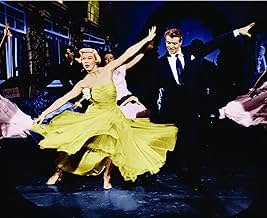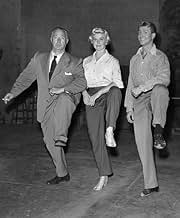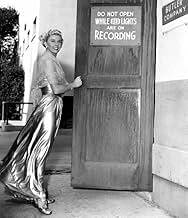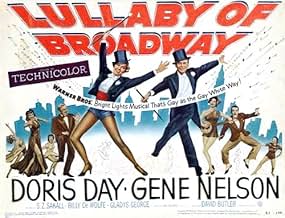AVALIAÇÃO DA IMDb
6,7/10
1,3 mil
SUA AVALIAÇÃO
Adicionar um enredo no seu idiomaA showgirl returns to her New York home to visit her alcoholic mother, where she catches the eye of a Broadway producer.A showgirl returns to her New York home to visit her alcoholic mother, where she catches the eye of a Broadway producer.A showgirl returns to her New York home to visit her alcoholic mother, where she catches the eye of a Broadway producer.
- Direção
- Roteirista
- Artistas
- Prêmios
- 2 vitórias no total
Bill Alcorn
- Dancer
- (não creditado)
Murray Alper
- Joe the Bartender
- (não creditado)
Jimmy Aubrey
- Ship's Steward
- (não creditado)
Brooks Benedict
- Reporter
- (não creditado)
Lulu Mae Bohrman
- Party Guest
- (não creditado)
Tex Brodus
- Party Guest
- (não creditado)
Avaliações em destaque
Light entertainment at its best, a great guilty pleasure for your pc.
This film boasts surprisingly strong performances by a solid cast: let's say it, a cast humble enough to throw themselves into an odd sort of film: part melodrama, part musical, part fashion show for its star.
Radiating joie-de-vivre, out-singing anyone of her time, serious one moment then tongue-in-cheek the next, Day is a star, an under-rated one these days.
Gene Nelson's dancing is important to see if only to better understand Fred Astaire's. The Astaire difference was this: talent, yes, Nelson had it as well, but not the ability to bring us to the brink of something endless through his motions: to make you know he was on the edge of something vast and mysterious; to suggest a whole unseen world by dancing in this one. Bravo, Fred!
This film boasts surprisingly strong performances by a solid cast: let's say it, a cast humble enough to throw themselves into an odd sort of film: part melodrama, part musical, part fashion show for its star.
Radiating joie-de-vivre, out-singing anyone of her time, serious one moment then tongue-in-cheek the next, Day is a star, an under-rated one these days.
Gene Nelson's dancing is important to see if only to better understand Fred Astaire's. The Astaire difference was this: talent, yes, Nelson had it as well, but not the ability to bring us to the brink of something endless through his motions: to make you know he was on the edge of something vast and mysterious; to suggest a whole unseen world by dancing in this one. Bravo, Fred!
If you love Fifties movie-musicals that stress music over story, "Lullaby of Broadway" is the prototype. It takes moviemaking back to the Astaire-Rogers films, which highlighted dancing, music, and wisecracking dialogue. "Lullaby" isn't quite "Top Hat", but it does represent a trend where old, sentimental hit tunes are given updated arrangements and settings.
In her autobiography, "Doris Day: Her Own Story" (published in 1976), the actress describes her early years as a contract player for Jack Warner and the heated disputes she had with the autocratic movie czar over miscasting and bad scripts. But in "Lullaby," there is virtually no script to complain about. It's mainly a revue. But what a revue! From Ray Heindorf's jazzy rendition of the old title tune (from "Gold Diggers of 1935") over the opening credits to the end, this movie clicks along in high gear from one showstopper to the next.
Day also recalled in her memoirs that "Lullaby" contained, by far, the toughest dance routines of any film she ever made. One especially challenging scene called for her to perform an intricate series of steps on a huge staircase while weighed down in a gold-lame dress. At first, she balked, warning the crew to have an ambulance waiting after the first take. With encouragement from the director David Butler and others, however, she managed to complete the number.
"Lullaby of Broadway" is not the best of the Day/Warners musicals--that distinction goes to "Calamity Jane" (1953)--but it's as good as the rest. With Gene Nelson as Day's love interest, Billy De Wolfe as a vaudevillian-turned-valet, and S. Z. Sakall as a Broadway "angel."
In her autobiography, "Doris Day: Her Own Story" (published in 1976), the actress describes her early years as a contract player for Jack Warner and the heated disputes she had with the autocratic movie czar over miscasting and bad scripts. But in "Lullaby," there is virtually no script to complain about. It's mainly a revue. But what a revue! From Ray Heindorf's jazzy rendition of the old title tune (from "Gold Diggers of 1935") over the opening credits to the end, this movie clicks along in high gear from one showstopper to the next.
Day also recalled in her memoirs that "Lullaby" contained, by far, the toughest dance routines of any film she ever made. One especially challenging scene called for her to perform an intricate series of steps on a huge staircase while weighed down in a gold-lame dress. At first, she balked, warning the crew to have an ambulance waiting after the first take. With encouragement from the director David Butler and others, however, she managed to complete the number.
"Lullaby of Broadway" is not the best of the Day/Warners musicals--that distinction goes to "Calamity Jane" (1953)--but it's as good as the rest. With Gene Nelson as Day's love interest, Billy De Wolfe as a vaudevillian-turned-valet, and S. Z. Sakall as a Broadway "angel."
If you can leave reality at the door, you're going to enjoy LULLABY OF Broadway. Doris returns from Europe hoping to surprise her mother who she thinks is a big Broadway star. She actually has fallen on bad times and is singing in a dive the the Village. When Doris arrives to her mothers supposedly grand home, the staff covers and says her mother is on tour. Instead of fretting, why doesn't she just ask what show and what city she is in? Then, of course, there would be no plot which is almost plot less anyway. Another "leave reality at the door" is when Gene Nelson at a gala says to Doris, "Hey, let's do that number we've been rehearsing" Then is seconds the full chorus and costumes and scenery appear!!! What?? Aside from that I really enjoyed this movie. Great numbers and wonderful acting by all. Too bad the story wasn't as good as the other aspects. This is part of the Doris Day collection and is certainly worth a look, implausible as it is. But then aren't all musicals?
In a different perspective of the plot for Lady For A Day, Warner Brothers gave Doris Day one of her best musical films in Lullaby Of Broadway. They even tributed Busby Berkeley somewhat in the finale number.
The story involves Doris as a young performer who has spent her childhood in the United Kingdom with money sent to her by her mother who she believes is a famous Broadway star. That's in the past tense unfortunately mom who is played by Gladys George now sings in a cheap cabaret in the seamier parts of Greenwich Village.
But Doris is such a good kid that everyone tries to keep the illusion going from former vaudeville colleagues Billy DeWolfe and Anne Triola to S.Z. Sakall whom they now work for as butler and maid. She even gets involved with rising new Broadway performer Gene Nelson. But she also innocently almost breaks up S.Z. Sakall's marriage to Florence Bates. Now there's a couple to contemplate about.
In her memoirs Doris Day said that S.Z. Sakall in real life was the same lovable uncle type that he played so well in films. And yes no one could resist pinching those cheeks either.
Gene Nelson sad to say came along just a half generation too late to become a major film star. He had the moves and he had the talent, possibly he was not a creative individual in the way that Fred Astaire or Gene Kelly was. I think he was in their league as a performer and he'd be as known as they are today if he had that creative talent that they did which is why they've become the legends they are. Maybe Nelson never got the chance they did. Anyway this was his only lead in a major motion picture and it didn't make him a star because musicals were on the downside.
Gladys George has only a few scenes, but she really makes them count when she's on screen. One of her more memorable characters in earlier years was the Texas Guinan like performer in The Roaring Twenties who carries a torch for James Cagney. When that film ends she's singing in a dive and her character could be an extension of Panama whom she played in The Roaring Twenties.
As often as not for Doris Day films Warner Brothers reached into their trunk catalog and in this case got the title song and another standard written by Harry Warren and Al Dubin, You're Getting To Be A Habit With Me. Here though they outdid themselves for Doris and Gene using stuff like Somebody Loves Me and Just One Of Those Things. When you've got George Gershwin and Cole Porter contributing to the score the rest doesn't even matter.
Watching the finale number which is the title song, sung by Doris and danced by Gene Nelson and a chorus it plays very similar to the choreographic sequences in Golddiggers of 1935 where Lullaby Of Broadway was introduced. No kaleidoscopic overhead shots that characterized those old Warner Brothers musicals from the Thirties are here, but in all other respects they seem to have copied Mr. Berkeley well.
Lullaby Of Broadway has a nice backstage plot, it's a throwback to their musicals of the Depression in many respects and it provides Doris Day with many opportunities to display singing and dancing talents. And it holds up well today.
The story involves Doris as a young performer who has spent her childhood in the United Kingdom with money sent to her by her mother who she believes is a famous Broadway star. That's in the past tense unfortunately mom who is played by Gladys George now sings in a cheap cabaret in the seamier parts of Greenwich Village.
But Doris is such a good kid that everyone tries to keep the illusion going from former vaudeville colleagues Billy DeWolfe and Anne Triola to S.Z. Sakall whom they now work for as butler and maid. She even gets involved with rising new Broadway performer Gene Nelson. But she also innocently almost breaks up S.Z. Sakall's marriage to Florence Bates. Now there's a couple to contemplate about.
In her memoirs Doris Day said that S.Z. Sakall in real life was the same lovable uncle type that he played so well in films. And yes no one could resist pinching those cheeks either.
Gene Nelson sad to say came along just a half generation too late to become a major film star. He had the moves and he had the talent, possibly he was not a creative individual in the way that Fred Astaire or Gene Kelly was. I think he was in their league as a performer and he'd be as known as they are today if he had that creative talent that they did which is why they've become the legends they are. Maybe Nelson never got the chance they did. Anyway this was his only lead in a major motion picture and it didn't make him a star because musicals were on the downside.
Gladys George has only a few scenes, but she really makes them count when she's on screen. One of her more memorable characters in earlier years was the Texas Guinan like performer in The Roaring Twenties who carries a torch for James Cagney. When that film ends she's singing in a dive and her character could be an extension of Panama whom she played in The Roaring Twenties.
As often as not for Doris Day films Warner Brothers reached into their trunk catalog and in this case got the title song and another standard written by Harry Warren and Al Dubin, You're Getting To Be A Habit With Me. Here though they outdid themselves for Doris and Gene using stuff like Somebody Loves Me and Just One Of Those Things. When you've got George Gershwin and Cole Porter contributing to the score the rest doesn't even matter.
Watching the finale number which is the title song, sung by Doris and danced by Gene Nelson and a chorus it plays very similar to the choreographic sequences in Golddiggers of 1935 where Lullaby Of Broadway was introduced. No kaleidoscopic overhead shots that characterized those old Warner Brothers musicals from the Thirties are here, but in all other respects they seem to have copied Mr. Berkeley well.
Lullaby Of Broadway has a nice backstage plot, it's a throwback to their musicals of the Depression in many respects and it provides Doris Day with many opportunities to display singing and dancing talents. And it holds up well today.
I saw this when I was a small boy, when it was revived in a neighborhood theatre, and then many years later on TV. Finally, with the advent of the VCR, I purchased this entertaining musical.
This is probably the picture that caused me fall in love with Doris Day. That personality! That smile! That Voice! From the opening number, "Just One of Those Things," to the last spectacular song and dance of "Lullaby of Broadway," this is a delight.
I especially enjoyed Doris' scenes with Gladys George (not "Cooper") as someone else reported. "It's tough being a mother. I need a couple more rehearsals." She was wonderful as Jessica Howard, has-been star of Broadway, now singing in a Greenwich Village dive.
Gene Nelson was mischievous as the lecherous dancer who chases Miss Day and Billy DeWolfe was inappropriately prissy as the "boyfriend" of Ann Triola. Of course, I always enjoy watching S. Z. "Cuddles" Sakall. This was his third time appearing with Miss Day.
Doris looked fantastic in Technicolor and the many closeups they gave her underscored her natural beauty, even though her freckles were covered up. She sang very nicely and danced up a storm with Gene Nelson, something that if done today, would get Oscar nominations. I especially enjoyed "You're Getting to Be a Habit with Me" and "I Love The Way You Say Goodnight." I was disappointed that Miss Day didn't have a ballad in this picture. What an oversight!
Day and her ilk made it look too easy, even though a LOT of work went into making these films.
This is probably the picture that caused me fall in love with Doris Day. That personality! That smile! That Voice! From the opening number, "Just One of Those Things," to the last spectacular song and dance of "Lullaby of Broadway," this is a delight.
I especially enjoyed Doris' scenes with Gladys George (not "Cooper") as someone else reported. "It's tough being a mother. I need a couple more rehearsals." She was wonderful as Jessica Howard, has-been star of Broadway, now singing in a Greenwich Village dive.
Gene Nelson was mischievous as the lecherous dancer who chases Miss Day and Billy DeWolfe was inappropriately prissy as the "boyfriend" of Ann Triola. Of course, I always enjoy watching S. Z. "Cuddles" Sakall. This was his third time appearing with Miss Day.
Doris looked fantastic in Technicolor and the many closeups they gave her underscored her natural beauty, even though her freckles were covered up. She sang very nicely and danced up a storm with Gene Nelson, something that if done today, would get Oscar nominations. I especially enjoyed "You're Getting to Be a Habit with Me" and "I Love The Way You Say Goodnight." I was disappointed that Miss Day didn't have a ballad in this picture. What an oversight!
Day and her ilk made it look too easy, even though a LOT of work went into making these films.
Você sabia?
- CuriosidadesWhen Doris Day's character is questioned by reporters about an affair she's supposedly having with S.Z. Sakall's character, one of them asks her, "Is it true you call him 'Cuddles'?" This is an inside joke, as Sakall's nickname in real life was "Cuddles".
- Erros de gravaçãoGloria reads a copy of Variety with news on the back cover; in reality, the back cover of this publication has always been reserved for full-page ads.
- Citações
Melinda Howard: [handing Tom a penny] There's a message on that to you from the women of the world.
Tom Farnham: In God We Trust
- ConexõesFeatured in The 69th Annual Academy Awards (1997)
- Trilhas sonorasLullaby of Broadway
(uncredited)
Music by Harry Warren
Lyrics by Al Dubin
Sung by Doris Day
Danced by DDoris Day and Gene Nelson and mixed chorus
Principais escolhas
Faça login para avaliar e ver a lista de recomendações personalizadas
- How long is Lullaby of Broadway?Fornecido pela Alexa
Detalhes
- Data de lançamento
- País de origem
- Idioma
- Também conhecido como
- Lullaby of Broadway
- Locações de filme
- Empresa de produção
- Consulte mais créditos da empresa na IMDbPro
- Tempo de duração1 hora 32 minutos
- Proporção
- 1.37 : 1
Contribua para esta página
Sugerir uma alteração ou adicionar conteúdo ausente


































